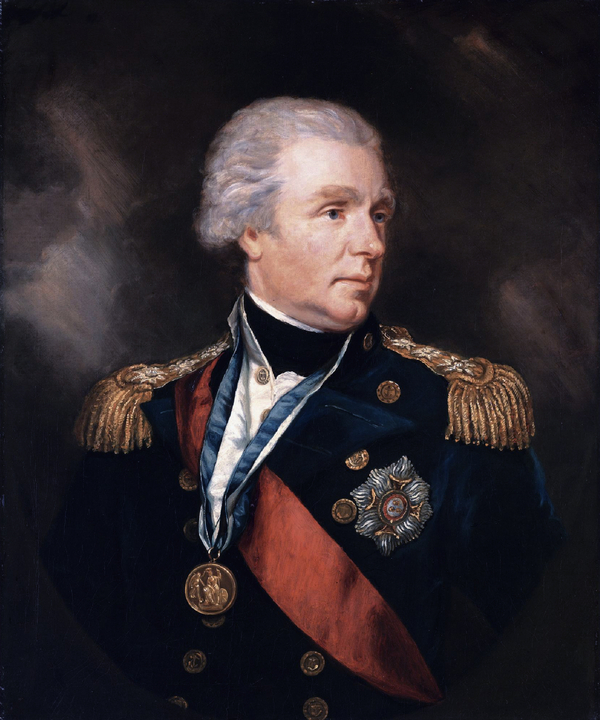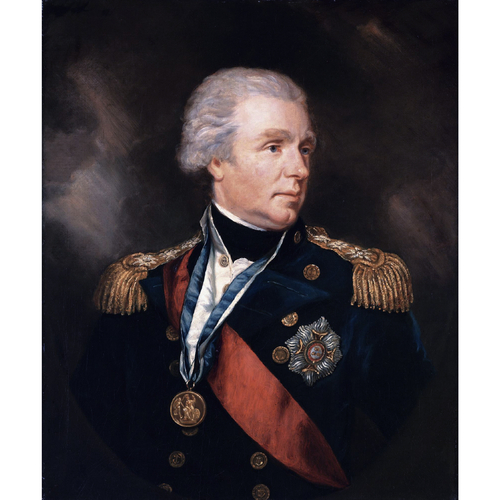
Source: Courtesy of Wikimedia Commons
WALDEGRAVE, WILLIAM, 1st Baron RADSTOCK, naval officer and governor of Newfoundland; b. 9 July 1753, second son of John Waldegrave, 3rd Earl Waldegrave, and Lady Elizabeth Gower; m. 28 Dec. 1785 Cornelia van Lennap in Smyrna (İzmir, Turkey), and they had two sons; d. 20 Aug. 1825 in England.
William Waldegrave entered the British navy in 1766, was promoted lieutenant in 1772, and by 1775 had command of his own ship. He served with distinction, rising to rear-admiral in 1794, and to vice-admiral a year later. In the fleet under Sir John Jervis, Waldegrave, as third in command, took part in the battle of Cape St Vincent off the Portuguese coast on 14 Feb. 1797, and was offered a baronetcy for his role in the victory. He declined, apparently thinking this honour inferior to his rank as an earl’s son. The patent appointing him governor and commander-in-chief of the island of Newfoundland “and the Islands adjacent, including the Islands of Saint Pierre and Miquelon,” was dated 16 May 1797.
Waldegrave’s administration occurred in wartime in an exposed corner of the British empire. In September 1796 a French squadron had attacked and burned Bay Bulls, a settlement just south of St John’s, and the constant French menace ensured that military concerns remained paramount in Waldegrave’s government. The topics of much of his correspondence are convoys, batteries, recruiting, and deserters – this last a serious problem in view of the inhabitants’ tendency to shelter runaways. Nor were the French the only threat. Soon after his arrival in the summer of 1797, the governor found that a mutiny in the British fleet had spread to Newfoundland, and a dangerous uprising among seamen on the Latona had to be put down. Though “the most perfect tranquility” prevailed among the 5,000 or so inhabitants of St John’s, Waldegrave thought it necessary to have an apparent onshore sympathizer, one Sergeant James Dayley, take the oath of allegiance in public before the magistrates. The mutineers had, he thought, tried to sow sedition among the soldiers in the garrison, many of whom were Irish Roman Catholics. Later events would show that his fears were not unfounded [see James Louis O’Donel*].
Waldegrave was governor for the usual triennium, but he stayed in Newfoundland for only about three months per year, departing for England in late October. This was the traditional system of British rule in Newfoundland, a system implying that government was needed only during the fishing season. John Reeves in 1791 had already pointed out to authorities in London the preposterousness of the arrangement. The island, he stated, “is no longer a place resorted to only by mere Fishermen”; and further, “there are many Merchants who do not engage at all in the Fishery.” He added that the population had “encreased so much in number, as to Compose a Society,” and that a local “legislative power” would be of benefit. Some recognition was given to these changed conditions during Waldegrave’s term as governor, when it was decided (in 1798) to have the chief justice reside year-round in St John’s. Yet official reluctance to concede that Newfoundland was becoming a colony comme les autres persisted, and Waldegrave maintained the age-old restrictions against building houses and issued proclamations against dieters (as servants who stayed over the winter were termed). When the four St John’s magistrates, acting as a sort of unofficial legislature, protested that “circumstances [were] so changed” in Newfoundland during wartime that these regulations no longer made sense, he replied that there were indeed reasons “for not pushing [dieters] too closely,” and that “it never was my intention” to bring proclamations against buildings “into full force.” As with most governors in the period 1770–1820, Waldegrave’s imperial bark was worse than his bite. Yet he occasionally used his authority to forbid the erection of houses and to order others taken down.
Despite the pretence that no year-round government was needed, one in fact already existed, an informal and to some extent voluntarist structure comprising magistrates, resident surrogates, sheriff, and other officials. The population of Newfoundland had increased to around 30,000, and changes taking place in the local economy and society demanded attention. The south coast fishery, especially the herring fishery, was expanding, and with it the number of settlers in Fortune Bay and Bay d’Espoir. The gang rape of a woman by five men near Harbour Breton brought forcibly home to Waldegrave the need for protection of settlers on what was a lawless frontier. Another new factor in the economy was the seal fishery, carried out in ocean-going vessels in early spring and hence requiring a work-force that was permanently resident on the island. It was not possible, especially in wartime, to bring servants out annually from Britain to man this fishery. The war also compelled the issuing of licences to permit the importation of provisions from the United States, and with the growth of trade, emigration to that country reached a level that worried the governor. He also found reason to be concerned about the rising influence of Methodists and Roman Catholics, and he fretted about the number and condition of the poor. A decent and humane man, Waldegrave took steps to have established a “Committee for the Relief of the Poor” to collect money from residents of St John’s. Over the winter of 1797–98, close to 300 people, more than half of them children, were given assistance from this source. The governor himself contributed generously to the fund, put pressure on the garrison and squadron to do likewise, and urged, with some success, that similar funds be set up in the outports.
The class of inhabitants that created the greatest uneasiness for Waldegrave were the merchants, now a strong and organized interest group in local society. “The power of the Merchants in the Out Harbors,” he told the Home secretary, “is so great, that they rule as perfect despots, being the sole possessors of the meat, drink and clothing by which their wretched subjects are supported.” Waldegrave recommended to London that magistrates be paid salaries, from a tax on rum and dieters, to remove them from the merchants’ influence. On being asked for their views on a tax on rum by Chief Justice Richard Routh* – an action for which he was angrily rebuked by Waldegrave – the St John’s merchants expressed vehement opposition, and in the event the proposal for a salaried magistracy was dropped. In their letter to Routh late in 1798, the merchants expressed concern that “we are not even allowed to build or repair our Houses except for the express purpose of carrying on the Fishery,” and argued that the poor should be allowed to cultivate parts of the island. These would be themes taken up by reformers in the next century [see William Carson*]. Though he was obliged to have dealings with the merchants, Waldegrave thought them upstarts. Towards the end of his term as governor he wrote dispatches denouncing their “insolent idea of independence” and warning of their influence on the population. The island, he wrote, is “of all Places in His Majesty’s Dominions, the one most prone to adopt the doctrines of Liberty & Equality” In comments such as these, Waldegrave seems to have been overreacting to minor stirrings of discontent.
Waldegrave was succeeded as governor by Charles Morice Pole, whose patent was dated 3 June 1800. Later in that year Waldegrave was created an Irish peer, with the title Baron Radstock, and in 1802 he was made an admiral. In effect, the governorship of Newfoundland was his last employment in the service of his country.
Waldegrave was a cautious, conservative, and perhaps hypersensitive governor. He defended with firmness, though not with great skill or patience, the interests of the mother country, and responded with compassion to the distressed members of the local community.
NMM, WYN (mfm. at PANL). PANL, GN 2/1/A, 12–15. PRO, CO 194/38–42; CO 195/15. DNB. James Ralfe, The naval biography of Great Britain . . . (4v., London, 1828), 2:27–31. W. L. Clowes, The Royal Navy; a history from the earliest times to the present (7v., London, 1897–1903). Prowse, Hist. of Nfld (1895).
Cite This Article
Patrick O’Flaherty, “WALDEGRAVE, WILLIAM, 1st Baron RADSTOCK,” in Dictionary of Canadian Biography, vol. 6, University of Toronto/Université Laval, 2003–, accessed January 18, 2026, https://www.biographi.ca/en/bio/waldegrave_william_6E.html.
The citation above shows the format for footnotes and endnotes according to the Chicago manual of style (16th edition). Information to be used in other citation formats:
| Permalink: | https://www.biographi.ca/en/bio/waldegrave_william_6E.html |
| Author of Article: | Patrick O’Flaherty |
| Title of Article: | WALDEGRAVE, WILLIAM, 1st Baron RADSTOCK |
| Publication Name: | Dictionary of Canadian Biography, vol. 6 |
| Publisher: | University of Toronto/Université Laval |
| Year of publication: | 1987 |
| Year of revision: | 1987 |
| Access Date: | January 18, 2026 |



